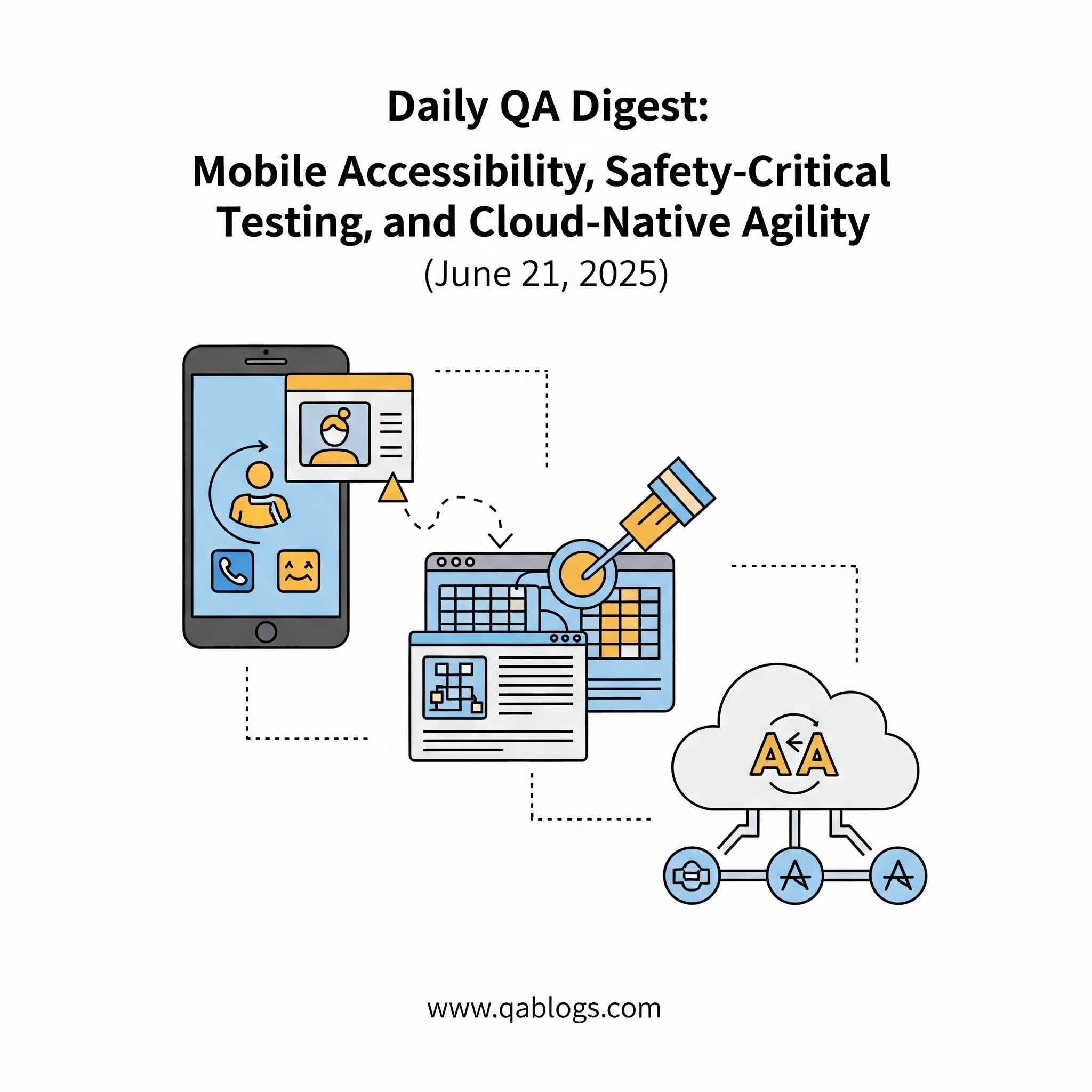Daily QA Digest: Mobile Accessibility, Safety-Critical Testing, and Cloud-Native Agility (June 21, 2025)

Key Takeaways
- The European Accessibility Act (EAA), effective June 28, 2025, mandates mobile accessibility (WCAG 2.2); QA teams should use tools like axe-core and manual testing.
- Safety-critical testing (e.g., ISO 26262, IEC 62304) is crucial for automotive and healthcare sectors; Model-Based Testing (MBT) and fault injection are key techniques.
- Cloud-native QA requires robust testing of microservices using Docker, Kubernetes, and performance tools like JMeter to ensure agility and scalability.
- QA professionals must adapt by upskilling in accessibility standards, safety-critical methodologies, and cloud-native testing tools and practices.
As software continues to power every facet of our digital lives, quality assurance (QA) remains the backbone of delivering reliable, inclusive, and agile applications. The QA landscape in 2025 is shaped by pressing demands for accessibility, safety, and scalability, particularly in mobile applications, safety-critical systems, and cloud-native architectures. With the European Accessibility Act (EAA) taking effect on June 28, 2025, and industries like healthcare, automotive, and finance prioritizing safety-critical testing, QA professionals must adapt to new challenges. Meanwhile, cloud-native agility is transforming how teams deliver software at scale. This Daily QA Digest for June 21, 2025, explores mobile accessibility, safety-critical testing, and cloud-native agility, offering actionable insights for QA engineers, testers, developers, and tech professionals to elevate their testing strategies.
Mobile Accessibility: Ensuring Inclusive Digital Experiences
The Importance of Mobile Accessibility
With over 6.8 billion smartphone users worldwide in 2025, mobile applications are a primary touchpoint for digital interactions. The EAA, effective June 28, 2025, mandates that digital products and services, including mobile apps, meet accessibility standards to ensure equal access for users with disabilities. Accessibility testing ensures that apps comply with standards like the Web Content Accessibility Guidelines (WCAG) 2.2, covering features such as screen reader compatibility, keyboard navigation, and color contrast.
Stat: A 2024 survey found that 85% of mobile apps fail basic accessibility checks, highlighting the urgent need for robust testing frameworks.
Key Tools and Techniques for Mobile Accessibility Testing
- Automated Accessibility Tools: Tools like axe-core and Google’s Accessibility Scanner integrate with CI/CD pipelines to detect issues like missing alt text or insufficient contrast ratios. These tools support the Accessible Rich Internet Applications (ARIA) framework, critical for EAA compliance.
- Manual Testing: Exploratory testing by QA engineers simulates user experiences with assistive technologies like VoiceOver (iOS) or TalkBack (Android) to identify edge cases.
- User-Centric Testing: Collaborate with users with disabilities to validate real-world usability, ensuring apps are intuitive and inclusive.
Real-World Example: A retail app redesigned its checkout flow using axe-core to address WCAG violations, reducing cart abandonment by 20% for users with visual impairments.
Challenges and Solutions
- Challenge: Balancing accessibility with rapid release
cycles.
Solution: Embed automated accessibility checks in DevOps workflows using tools like Deque’s axe DevTools to catch issues early. - Challenge: Limited expertise in accessibility
standards.
Solution: Upskill QA teams through resources like Deque University or WCAG-focused webinars, such as Lumar’s Global Accessibility Awareness Day event.
Practical Takeaway: Integrate accessibility testing into every sprint using tools like axe-core and manual audits to ensure EAA compliance and enhance user inclusivity.
Safety-Critical Testing: Ensuring Reliability in High-Stakes Systems
Why Safety-Critical Testing Matters
Safety-critical systems, such as those in healthcare, automotive, and aerospace, demand rigorous testing to prevent failures that could lead to harm. In 2025, the rise of AI-driven medical devices and autonomous vehicles has amplified the need for safety-critical testing to ensure compliance with standards like ISO 26262 (automotive) and IEC 62304 (medical devices).
Analogy: Safety-critical testing is like a pilot’s pre-flight checklist—every component must be verified to ensure the system operates flawlessly under all conditions.
Key Approaches to Safety-Critical Testing
- Model-Based Testing (MBT): Tools like Simulink and IBM Rational Rhapsody simulate system behavior to validate safety requirements, reducing the risk of defects in production.
- Fault Injection Testing: Intentionally introduce failures (e.g., network latency or sensor errors) to assess system resilience, critical for autonomous vehicles.
- Traceability: Use tools like TestRail or Zephyr to map test cases to regulatory requirements, ensuring compliance with standards like ISO 26262.
Real-World Example: A medical device company used MBT to validate a pacemaker’s firmware, identifying a timing issue that could have caused irregular heartbeats, saving millions in potential recalls.
Challenges and Solutions
- Challenge: High complexity of safety-critical
systems.
Solution: Leverage AI-driven testing tools like mabl to generate test cases for complex scenarios, improving coverage. - Challenge: Regulatory compliance across
jurisdictions.
Solution: Implement traceability matrices in TestRail to align tests with standards like IEC 62304, streamlining audits.
Practical Takeaway: Adopt MBT and fault injection testing to validate safety-critical systems, and use traceability tools to ensure compliance with regulatory standards.
Cloud-Native Agility: Accelerating QA in Modern Architectures
The Shift to Cloud-Native Development
Cloud-native applications, built on microservices, containers, and Kubernetes, enable scalability and rapid deployments. Tokyo Gas’s 2025 success with Kubernetes and Argo CD at KubeCon demonstrates how cloud-native agility reduces costs by 30% through dynamic scaling. QA teams must adapt to test these distributed systems effectively, ensuring performance, security, and scalability.
Key Tools and Strategies for Cloud-Native QA
- Containerized Testing Environments: Tools like Docker and Kubernetes create production-like environments for testing, reducing environment-specific bugs.
- Performance and Scalability Testing: Use JMeter or NeoLoad to simulate real-world workloads and validate auto-scaling policies, as recommended by AWS’s Well-Architected Framework.
- Service Mesh Testing: Tools like Istio ensure reliable communication between microservices, critical for cloud-native apps.
Stat: 71% of organizations rely on Agile-driven workflows in 2025, emphasizing the need for cloud-native testing to support rapid releases.
Comparing Traditional vs. Cloud-Native QA
| Aspect | Traditional QA | Cloud-Native QA |
|---|---|---|
| Environment Setup | Manual, hardware-dependent | Automated with Docker/Kubernetes |
| Scalability Testing | Limited to static environments | Dynamic, simulates real-world workloads |
| Speed | Slow due to manual processes | Fast, integrated with CI/CD pipelines |
| Tooling | Legacy tools (e.g., HP ALM) | Modern tools (e.g., JMeter, Istio) |
| Focus | Functional testing | Performance, scalability, and security |
Analysis: Cloud-native QA aligns with Agile and DevOps, enabling faster feedback loops and scalability testing. Traditional QA struggles with the complexity of distributed systems, making tools like Kubernetes essential for 2025.
Challenges and Solutions
- Challenge: Testing microservices with endless
integrations.
Solution: Use contract testing tools like Pact to validate service interactions without full system deployment. - Challenge: Managing test data in cloud
environments.
Solution: Implement synthetic data generation and data masking to comply with GDPR and CCPA regulations.
Practical Takeaway: Integrate containerized testing with Kubernetes and performance tools like JMeter into CI/CD pipelines to ensure cloud-native apps are scalable and secure.
Practical Insights for QA Professionals
- Prioritize Accessibility Testing: Use axe-core and manual audits to meet EAA requirements, focusing on WCAG 2.2 compliance for mobile apps.
- Upskill in Safety-Critical Testing: Learn MBT and fault injection techniques through platforms like Coursera to test high-stakes systems effectively.
- Adopt Cloud-Native Tools: Leverage Docker, Kubernetes, and JMeter to test microservices and ensure scalability in cloud-native environments.
- Integrate AI-Driven Testing: Use tools like mabl for predictive analytics and self-healing scripts to enhance test efficiency across all domains.
- Attend QA Conferences: Join events like TestCon Europe (October 21–24, 2025) or QA or the Highway (June 27, 2025) to stay updated on accessibility, safety-critical, and cloud-native trends.
Conclusion: Shaping the Future of QA in 2025
The QA landscape in 2025 demands a strategic focus on mobile accessibility, safety-critical testing, and cloud-native agility to meet evolving user expectations and regulatory requirements. By embracing tools like axe-core for accessibility, Simulink for safety-critical systems, and Kubernetes for cloud-native testing, QA professionals can deliver inclusive, reliable, and scalable software. As the EAA deadline looms and industries prioritize safety and agility, now is the time to act.
Ready to elevate your QA strategy? Explore tools like mabl or Docker, attend QA conferences like TestCon Europe, and share your insights in the comments below. Contact QA Blogs for tailored advice on mastering these trends. Let’s drive quality forward together in 2025!
Join Our Community of QA Professionals
Get exclusive access to in-depth articles, testing strategies, and industry insights. Stay ahead of the curve with our expert-curated content delivered straight to your inbox.

Nikunj Mistri
Founder, QA Blogs



